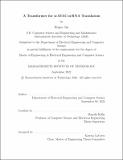| dc.contributor.advisor | Kellis, Manolis | |
| dc.contributor.author | Jin, Roger | |
| dc.date.accessioned | 2023-01-19T19:49:51Z | |
| dc.date.available | 2023-01-19T19:49:51Z | |
| dc.date.issued | 2022-09 | |
| dc.date.submitted | 2022-09-16T20:23:33.197Z | |
| dc.identifier.uri | https://hdl.handle.net/1721.1/147430 | |
| dc.description.abstract | scATAC-seq gives a comprehensive picture of the chromatin accessibility profile of a cell, covering not only protein-coding regions but also non-coding regulatory regions which are in theory missed by scRNA-seq. However, scATAC-seq data is highdimensional and noisy, aspects which when compounded with data scarcity present challenges for modeling on even seemingly-simple downstream tasks such as cell-type prediction. As such, researchers may benefit from access to a large library of models to evaluate. While we do not demonstrate state of the art results in any capacity, we provide an implementation of a simple representation of sparse tabular data that allows it to be inputted into the popular transformer family of architectures, and use this representation to train a transformer that predicts scRNA-seq given scATAC-seq. Our code is made available here https://github.com/rogershijin/GANOLI. | |
| dc.publisher | Massachusetts Institute of Technology | |
| dc.rights | In Copyright - Educational Use Permitted | |
| dc.rights | Copyright MIT | |
| dc.rights.uri | http://rightsstatements.org/page/InC-EDU/1.0/ | |
| dc.title | A Transformer for scATAC-scRNA Translation | |
| dc.type | Thesis | |
| dc.description.degree | M.Eng. | |
| dc.contributor.department | Massachusetts Institute of Technology. Department of Electrical Engineering and Computer Science | |
| mit.thesis.degree | Master | |
| thesis.degree.name | Master of Engineering in Electrical Engineering and Computer Science | |
